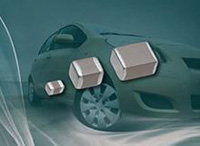By TDK Corporation 32

TDK's high-capacitance MLCC offer a rated voltage of 100 V for mid-voltage applications. TDK’s multilayer ceramic chip capacitors (MLCC) use ceramic dielectric thin-layer and multi-layering technologies to improve capacitance to the industry’s highest levels in the mid-voltage range.
As the fundamental driving performance of automobiles improves, and comfort and safety functions become more advanced, there is a substantial increase in the use of electronic equipment. In addition, next-generation eco-friendly cars that can contribute to reducing environmental impact through better fuel efficiency and lower carbon dioxide emissions have attracted considerable attention. Amidst these developments, the number of electronic devices installed in limited space is increasing, and market demand is rising for components that can contribute to the miniaturization of capacitance. TDK is responding to these market needs by using its strengths in materials and multi-layering technologies to reduce the gaps between ceramic dielectric layers by approximately 40% compared to earlier products. Additionally, sintering conditions were optimized to maintain the reliability needed for automobile on-board MLCCs while making components smaller and increasing capacitances.
As a result, these products have the same capacitance of earlier TDK components but are approximately 50% smaller. They feature X7S temperature characteristics (operating temperature range: -55°C to 125°C; change in capacitance: ±22%), making them ideal for use in engine compartments as well as the switching power supply smoothing circuits needed for industrial equipment.
Features and Benefits